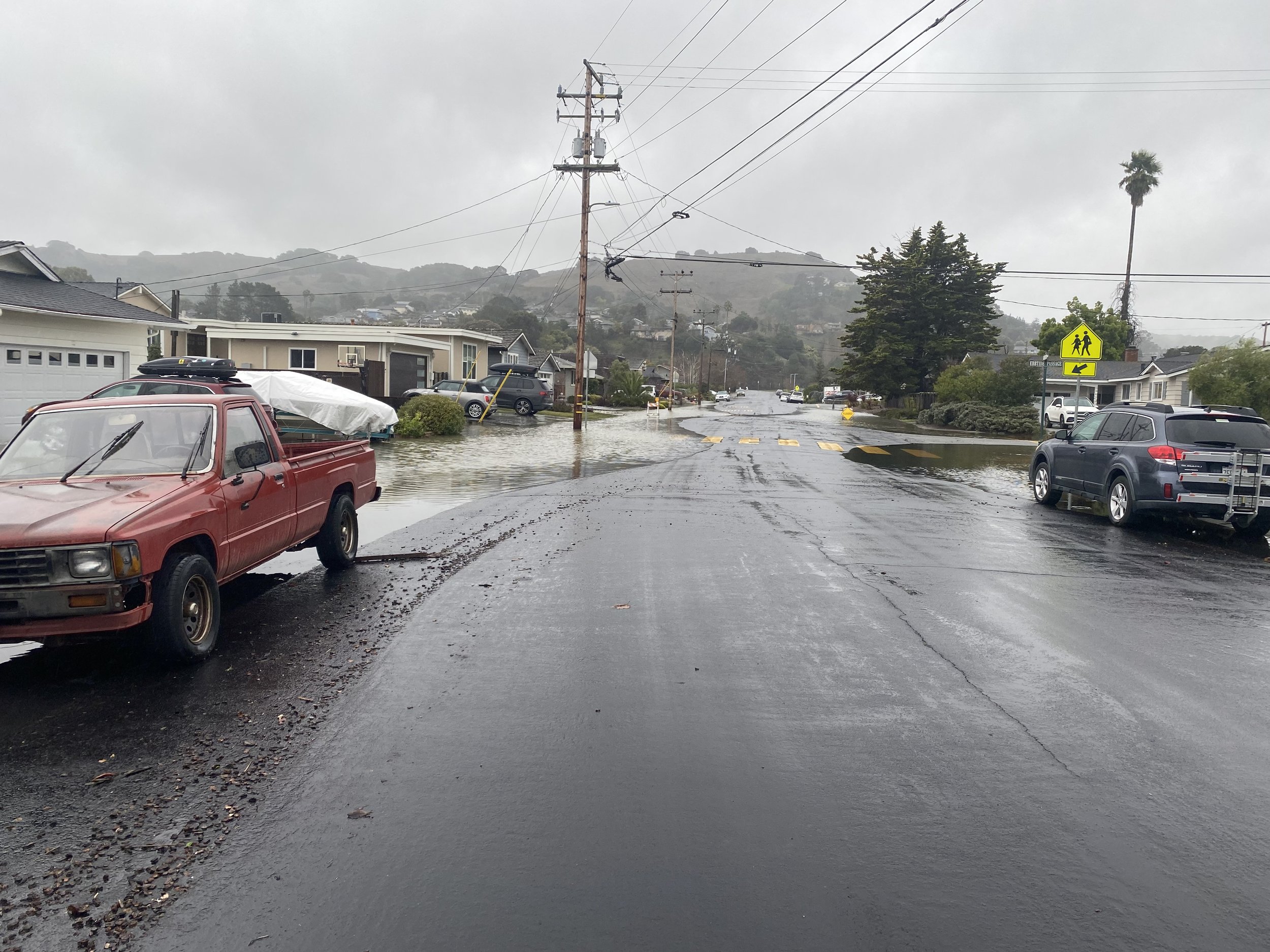Multiple factors contribute to flooding in Corte Madera’s bayside neighborhoods, including high tides, stormwater runoff, settlement (also known as subsidence), sea level rise, and storm drainage infrastructure that was part of the original developments and is no longer adequate to meet current needs. Long-term factors like settlement and sea level rise are, over time, increasing the flood risk that shoreline neighborhoods face by lowering neighborhood elevations and increasing water levels, respectively. Short-term factors, like high tides and storm events, build on existing vulnerabilities to cause temporary flooding. Learn more about these factors below.
Long-Term Factors:
Settlement: The bayside neighborhoods of Mariner Cove and Marina Village were built on filled baylands in the 1950’s. The neighborhoods have subsided as the bay mud and former marsh solids consolidate under the weight of the overlying infrastructure (e.g., earth fill, roads, homes). These neighborhoods have settled up to four feet since construction (depending on the thickness of the bay mud) and are projected to continue settling for the coming decades, with an average of up to 2 additional feet of settlement by the end of the century. In some places, settlement has resulted in homes with tilted floors and storm drain pipelines that no longer flow as originally designed. For more information on settlement, see the Town-Wide Storm Drainage and Flood Control Study - Phase I, 2007, pp.10-11.
Sea Level Rise: Sea levels in San Francisco Bay have risen eight inches over the past century (CA Fourth Climate Change Assessment, 2018) and will continue to rise over the next century. The exact amount of sea level rise we see will depend on multiple factors, including how well we reduce our greenhouse gas emissions. The most recent guidance from the State of California recommends planning for 1-2 feet of sea level rise by 2050 (CA Sea Level Rise Guidance, 2018), with updated guidance expected to be released soon. Rising sea levels exacerbate the extent of tidal flooding, worsen creek overflow due to backwater effects of elevated high tides, elevate the groundwater table, and can intensify wave action that erodes the shoreline currently protecting infrastructure.
Short-Term Factors:
Stormwater Runoff: Many of Corte Madera’s storm drain systems rely on gravity pipes that discharge into the bay. During high tides, the pipe outfalls are often underwater and the storm water is unable to flow into the bay as it would if the tidal waters were below the pipe elevations. Events of this nature can flood streets and temporarily overwhelm the storm drainage infrastructure until the high tide subsides, and the “gravity” storm system is able to properly release the water that was temporarily trapped. In some places, a pump station to move stormwater from the streets has been constructed, but during extreme high tide events, pump stations can be overwhelmed by the combination of storm and tidal waters. Climate change is increasing the frequency and intensity of storm events, leading to more frequent and severe flooding.
King Tides: King tides are abnormally high predictable astronomical tides that occur approximately twice per year within San Francisco Bay. King Tides are the highest tides that occur each year and can exceed 7 feet above Mean Lower Low Water (MLLW). Learn more about king tides from NOAA and the California King Tides Project.
Extreme High Tides: When Pacific Ocean storms coincide with high tides, storm surge due to meteorological effects can further elevate San Francisco Bay water levels to produce extreme high tides.
El Niño: During El Niño winters, atmospheric and oceanographic conditions in the Pacific Ocean produce severe winter storms that impact the San Francisco Bay region. Pacific Ocean storms follow a more southerly route and bring intense rainfall and storm conditions to the Bay area. Tides are elevated by approximately 0.5 to 1.0 feet above normal along the coast and wind can elevate water levels even further locally. Learn more about El Niño and the emerging 2023/2024 El Niño event from the California Coastal Commission.
Wind Wave Events: Strong winds due to Pacific Ocean storms or strong thermal gradients produce strong winds that blow across the Bay. When the wind blows over long reaches of open water large waves can be generated that impact the shoreline and cause damage.
















